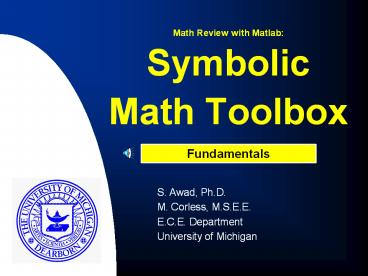S. Awad, Ph.D. - PowerPoint PPT Presentation
Title:
S. Awad, Ph.D.
Description:
Math Review with Matlab: Symbolic Math Toolbox Fundamentals S. Awad, Ph.D. M. Corless, M.S.E.E. E.C.E. Department University of Michigan Fundamentals of Matlab s ... – PowerPoint PPT presentation
Number of Views:71
Avg rating:3.0/5.0
Title: S. Awad, Ph.D.
1
Symbolic Math Toolbox
Math Review with Matlab
Fundamentals
- S. Awad, Ph.D.
- M. Corless, M.S.E.E.
- E.C.E. Department
- University of Michigan
2
Fundamentals of Matlabs Symbolic Toolbox
- Creating Symbolic Variables
- Defining Symbolic Expressions
- Defining Numerical Representation
- Converting Symbolic Variables to Doubles
- Creating Real Symbolic Variables
- Creating Complex Symbolic Variables
- Manipulating Abstract Functions
3
Defining Symbolic Variables
xsym('x')
- Use sym to create a symbolic variable x
syms y a b
- Use syms to create several symbolic variables at
one time
who Your variables are a b x y
- Use who to view al variables in the workspace
4
Viewing Workspace Variables
- Use whos to view all workspace variables with
their associated size, bytes, and class
information
n1.0t1.1 2.2 3.3 whos Name Size
Bytes Class a 1x1
126 sym object b 1x1 126
sym object n 1x1 8 double
array t 1x3 24 double
array x 1x1 126 sym object
y 1x1 126 sym object Grand
total is 12 elements using 536 bytes
5
Symbolic Expressions
- Symbolic Expressions
f 2x2 x 1 g ax2 bx 5 g
ax2bx5
- Symbolic and Numerical Conversions to perform a
mathematical operation and create a new symbolic
variable delta
delta sym('1sqrt(2)/2') f delta2
delta f (11/22(1/2))211/22(1/2)
6
Numerical Representation
- The command sym(A,flag) converts a numeric scalar
or matrix, A, to symbolic form
- The flag argument specifies the technique for
converting floating point numbers
'f' Exactly represents Floating Point values in
the form '1.F'2(e) or '-1.F'2(e) where F is a
string of 13 hexadecimal digits and e is an
integer. (This form may not be convenient for
subsequent manipulation)
'd' Represents Decimal numbers where the number
of digits is taken from the current setting of
DIGITS (described later)
7
Symbolic Representation Example
rho(1sqrt(5)/2)
- Double-Precision
- Floating Point
- Variable
rho 2.1180
rho_float sym(rho,'f') rho_float
'1.0f1bbcdcbfa54'2(1)
rho_decimal sym(rho,'d') rho_decimal
2.1180339887498949025257388711907
8
Digits Command
- The digits command is used to set the number of
digits of accuracy used for future numeric
computations on symbolic variables - digits(n) sets accuracy to n digits for
subsequent calculations. Where n represents an
integer
- digits, by itself, displays the current accuracy
(default 32 digits)
9
Digits Example
digits Digits 32 rho(1sqrt(5)/2)
rho_decimal sym(rho,'d')
- Default Precision (32 Digits)
rho_decimal 2.1180339887498949025257388711907
digits(7) rho_decimal_7sym(rho,'d')
rho_decimal_7 2.118034
Adjusted Precision (7 Digits)
10
Double Command
- The double command coverts a symbolic variable to
a general Matlab double floating point number
xsym(3)ysym(4) z_sym x/y z_sym 3/4
Symbolic Variable
z_float double(z_sym) z_float 0.7500
Double Float Variable
11
Declaring Real Variables
- To declare real symbolic variables
x sym('x','real') y sym('y','real')
- Or use shorthand notation
syms x y real who Your variables are x
y
12
Declaring Complex Variables
syms x y zxiy or zxjy z xiy
- To construct a complex number use i or j to
represent the imaginary part
z_real real(z) z_real x
- Use real to find the real part
- Use imag to find the imaginary part
z_imag imag(z) z_imag y
13
Unreal
- The 'unreal' argument to sym can be used to
convert a real variable to a purely formal
variable with no additional properties
xsym('x','real') conj(x) ans x
- If x is real, the complex conjugate of x will be x
- If x is unreal, the complex conjugate of can not
be further simplified
xsym('x','unreal') conj(x) ans conj(x)
14
Abstract Functions
- A symbolic variable can represent an abstract
function fsym('f(x)')where the input argument
is a string
- Abstract functions are useful for solving
algebraic and differential equations
fsym('2x2') f 2x2
15
Abstract Function Example
syms a b c z a 0 0 0 b 0 0 0 c z a,
0, 0 0, b, 0 0, 0, c
- Find the determinant and inverse of the matrix z
determinant det(z) determinant abc
inverse inv(z) inverse 1/a, 0, 0
0, 1/b, 0 0, 0, 1/c
16
Matrix Manipulation Example
- Change the first element of the matrix from a to
g
z(1,1)'g' z g, 0, 0 0, b, 0 0,
0, c
17
Summary
- Matlab can be used to create and manipulate
symbolic variables and expressions
- Symbolic variables representing numbers can be
displayed with adjustable accuracy
- The double command converts symbolic variables
into Matlab double precision floating point
variables
- Symbolic variables can be declared as real,
complex, or converted to the default unreal state
- Abstract functions can be created and manipulated
symbolically































